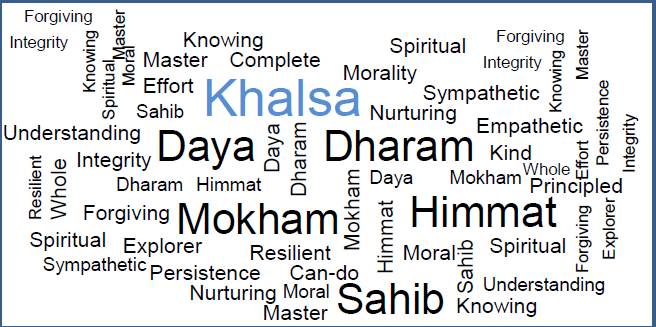 |
|
Panj Kakaar (Five K's)
Introduction
Guru Ji commanded that the Khalsa will be known for they will bear the stamp of the Guru by wearing on their person the Five Kakaar3. These are Kesh (known as the stamp of the Guru), Kanga worn in the Kesh, Kirpan worn on the torso, Kachera to cover ones modesty and lastly Kara to remind oneself of the presence of Waheguru4 in every sphere of one's life. Panj Kakaar
Historically and within the realms of modern culture this is a truly outstanding feature of the Khalsa. Modernity has established a norm that imposes on all those who claim to be modern almost a duty to shorn hair on the body. Those who do not observe this general rule are almost perceived as deviant within a society which is forever seeking conformity from its constituency. Guru Sahibs took a stand against this urgency to conform and established a way of living that was based on timeless principals.
In asking men and women to respect hair and look after them Guru Sahib7 also implicitly expected that men will not disown that part of their personality that was about nurturing, caring, empathy and gentleness.
An aspect the Kanga in combing full length hair is to remind the Sikh that good behaviours are worth persisting with. One does not become a whole person by magic. It requires persistence and the bearing of frustration just as one should spend time undoing the tangled hair. Repetition and meditation on Waheguru leads to contentment and fulfilment. Kanga served the purpose of the individual comb that will not carry disease or bacteria from one head to another. In modern times we have come to understand that sharing combs is not healthy. It protects the wearer from damage to their health. Health in its general sense was very important. The message from Guru Sahib was for the Sikh to be aware that cleansing was not just about the hair but also about the mind and one's thoughts and ideas. As one combed the hair one should become aware of those ideas and thoughts that separate us from the 'other'. The mind and its contents also need a comb. The form of that comb is Simran9. Kanga teaches the Sikh to bear frustration and accept that effort is required for each and every endeavour. Achievements do not come through magic or miracles but through persistence and commitment.
The full impact of the Kirpan can't be understood without a glimpse at history and a look at modern times. At the times of Guru Sahiban society was ridden with divisions in which the poor and the lower castes had no human rights let alone expectations of their protection from the powerful. Guru Nanak had already boldly stated that when the rulers and civic authority prey on its population what hope for justice and the rule of law. It was nay impossible for a poor man let alone a woman to even entertain the idea that they could wear or carry a Kirpan. This was sacrilege and unheard of. It was to this that Guru Sahiban turned his attention when he bestowed on the Khalsa the Kirpan. He explained that all had a right to live a life free of fear with honour and dignity. Men and women will be equal in society and treated with the same respect with no regard to their hierarchy or status. It will be their deeds that will count when it comes to offer them respect. This is remarkable considering that in general women were given the universal vote in modern times around 1920s'. Before this time the female had been treated as dependent on the male and as his property. Guru Sahiban in endowing the Khalsa with the sword was truly thinking and acting in a radical step far ahead of the times. The male was expected to shoulder and walk in step with his counterpart the female and know that they are both part objects of each other. The woman will no longer be seen or judged as the property of the man within the realms of the Khalsa of Guru Sahiban. In offering the Kirpan to the Khalsa Guru Sahib also had another purpose. In life there is a time and event at which each one of us utters the words," I don't have to get involved. I am on my own." The wearing of the Kirpan reminds the Khalsa that each individual has the power to make a difference to the community they live in. By the virtue of their presence one belongs to the community at that time and has responsibility towards it. The Khalsa must speak for those who are unable to and must take a stand on behalf of those who can't. The literal meaning of the word Kirpan is one who offers hope, blessing and refuge. Guru Sahib reframed the notion of the sword from a potency that was steeped in danger to one that would be filled with love for all.
Historically the poor and the wretched had little by way of garments that were meant to offer them protection from the elements. This was since their status in life was such that they were resigned to the idea that they had nothing to protect. Guru Sahib commenting on the status of the Sikhs had said," My Sikhs are not down trodden but equal of all". In putting this forward he was also making it clear that they had dignity, respect and rights as equals. The knot in the draw string puts emphasis on the wearer that they had personal responsibility for their desires and impulses. They could not put their failings on to others for their conduct.
Summary The above is a concise attempt at explaining the Panj Kakaar. It should be understood that every event occurs at a particular time and place, however it carries a message that is beyond the immediate. The events of 1699 and the proffering of the Panj Kakaar to the Khalsa was such an event as to give the human form the identity and sanctity to preserve its wholeness. It was a radical step in all aspects of the social, cultural and spiritual life of the times. Guru Nanak had come in to the world and announced that spiritual men can't sit on the fence and pretend that the ills of the world are not their domain. All the Guru Sahibans that followed took up this cry of human rights, dignity and universal good. The tenth Nanak in the form of Guru Gobind Singh Ji made the call at Anandpur; the city of bliss and acclaimed that the Khalsa will be the modern form for humankind. The doubt ridden ritualistic male domination would not be the home of his Khalsa. His Khalsa will be the enlightened being who through literature and valour will come to epitomise the human aspiration of freedom and human rights. My grateful thanks to Bhai Guljar Singh (Canada Wale) for his guidance and support. Also to those who have made available the pictures that I have used in this booklet. ------------------------------ Biblio: 1 In 1699 Guru Ji revealed the Khalsa to the world. |
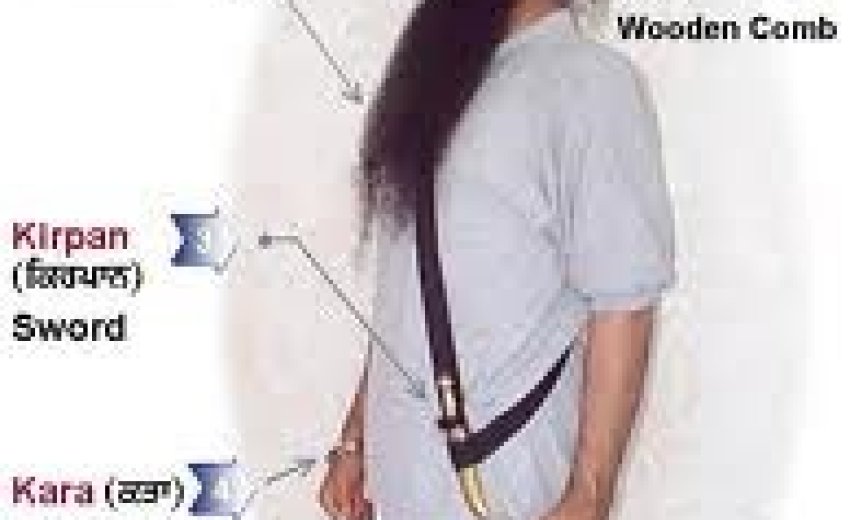
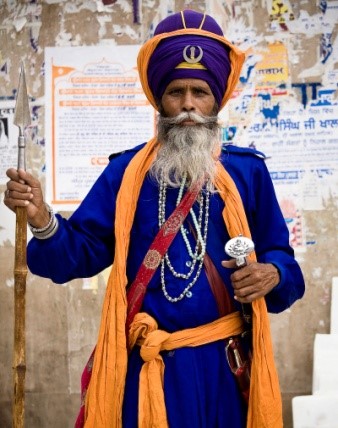 Guru Nanak (1469 - 1539) had established key principles for Sikhs. These were modelled by the nine Gurus that followed him. Implicitness of these principles required an expression. This came via Guru Gobind Singh Ji (1675 - 1708) as he revealed the Khalsa1 to the world. In bestowing a distinct character and identity Guru Gobind Singh Ji let it be known that the artefacts that he was offering the Khalsa were not mere whims of fashion but were integral to the Khalsa Rehat2 and Life. His command to the Khalsa was," Rehat pyari mujh ko, Sikh pyaraae nahin". It was the Sikh's life and conduct that were important; calling oneself Sikh is not enough to become a Sikh!
Guru Nanak (1469 - 1539) had established key principles for Sikhs. These were modelled by the nine Gurus that followed him. Implicitness of these principles required an expression. This came via Guru Gobind Singh Ji (1675 - 1708) as he revealed the Khalsa1 to the world. In bestowing a distinct character and identity Guru Gobind Singh Ji let it be known that the artefacts that he was offering the Khalsa were not mere whims of fashion but were integral to the Khalsa Rehat2 and Life. His command to the Khalsa was," Rehat pyari mujh ko, Sikh pyaraae nahin". It was the Sikh's life and conduct that were important; calling oneself Sikh is not enough to become a Sikh!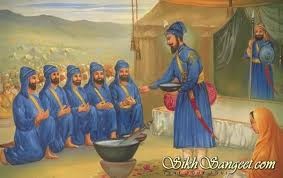 Those who participated and partook of Khanda Battae di Pahuul5 were commandeered by Guru Sahib to have the above Five Kakaar's on their person. There were no exceptions; anyone who claimed to be Guru Ji's Sikh would have the distinct identity and be forever recognised for they will stand out both for their conduct and their appearance. The Five K's in detail are;
Those who participated and partook of Khanda Battae di Pahuul5 were commandeered by Guru Sahib to have the above Five Kakaar's on their person. There were no exceptions; anyone who claimed to be Guru Ji's Sikh would have the distinct identity and be forever recognised for they will stand out both for their conduct and their appearance. The Five K's in detail are;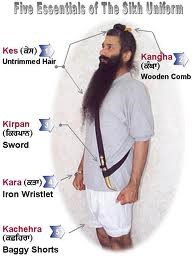 1. Kesh: All who wish to be known as the Khalsa will not allow the scissors or the knife to touch their hair. The hair will be worn unshorn and tied in a knot to keep them manageable. Guru Nanak Sahib in Aasa di Vaar6 had already said that loose hair are like the dust that blinds one's eyes. Guru Gobind Singh Ji also commanded his Sikhs to observe that hair should be kept clean and washed regularly. Matted hair were not allowed and accepted in his presence. Males should also take care of their beards and keep them clean as with the hair on the head. The beard of the male should not be touched by the scissors or the knife to shorten them.
1. Kesh: All who wish to be known as the Khalsa will not allow the scissors or the knife to touch their hair. The hair will be worn unshorn and tied in a knot to keep them manageable. Guru Nanak Sahib in Aasa di Vaar6 had already said that loose hair are like the dust that blinds one's eyes. Guru Gobind Singh Ji also commanded his Sikhs to observe that hair should be kept clean and washed regularly. Matted hair were not allowed and accepted in his presence. Males should also take care of their beards and keep them clean as with the hair on the head. The beard of the male should not be touched by the scissors or the knife to shorten them. 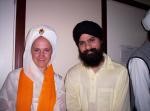 It is worth noting that while men were expected to cut hair women were meant to keep their hair long to define their femininity. There is still an expectation in society that we are almost forced to comment on a woman's hair style as offering some insight into her being.
It is worth noting that while men were expected to cut hair women were meant to keep their hair long to define their femininity. There is still an expectation in society that we are almost forced to comment on a woman's hair style as offering some insight into her being. 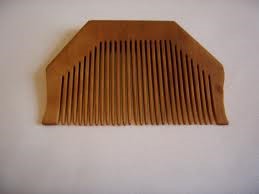 2. Kanga: Kanga was to be the instrument of cleansing. A Sikh should wear the Kanga in his/ her hair and regularly comb his/ her hair to keep them clean and tidy. He will also use the Kanga to clean his beard. Kanga should be simple and right for the purpose. It should not be ornamental and worn as a piece of jewellery. The Kanga in his hair/ her hair will remind the Sikh that just as the hair need cleansing his/ her mind also should be cleansed through the comb of Simran8.
2. Kanga: Kanga was to be the instrument of cleansing. A Sikh should wear the Kanga in his/ her hair and regularly comb his/ her hair to keep them clean and tidy. He will also use the Kanga to clean his beard. Kanga should be simple and right for the purpose. It should not be ornamental and worn as a piece of jewellery. The Kanga in his hair/ her hair will remind the Sikh that just as the hair need cleansing his/ her mind also should be cleansed through the comb of Simran8. 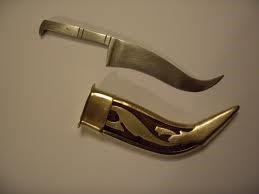 3. Kirpan: The Kirpan is a small sword that the Khalsa wears diagonally on his torso. The Kirpan shall remind him/ her of his/ her responsibilities to themselves and the community. In times of danger the Khalsa will know that he/ she is able to use the Kirpan as a weapon to defend oneself as well as lay waste to the enemy. The Kirpan reminds the Khalsa that he/ she has strength, power and agency. The Kirpan is a symbol of his/ her free will. It bears witness to the concept that he/ she is not a slave and beholden for protection to another. For the Khalsa the wearing of the Kirpan puts to bed the notion that the female is lesser than the male. The Khalsa female does not need the protection of the male for she is endowed by Guru Sahiban with the Kirpan to not only protect herself but also to protect others if need arises. She will sit in the company of equals.
3. Kirpan: The Kirpan is a small sword that the Khalsa wears diagonally on his torso. The Kirpan shall remind him/ her of his/ her responsibilities to themselves and the community. In times of danger the Khalsa will know that he/ she is able to use the Kirpan as a weapon to defend oneself as well as lay waste to the enemy. The Kirpan reminds the Khalsa that he/ she has strength, power and agency. The Kirpan is a symbol of his/ her free will. It bears witness to the concept that he/ she is not a slave and beholden for protection to another. For the Khalsa the wearing of the Kirpan puts to bed the notion that the female is lesser than the male. The Khalsa female does not need the protection of the male for she is endowed by Guru Sahiban with the Kirpan to not only protect herself but also to protect others if need arises. She will sit in the company of equals. 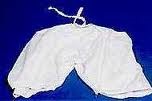 4. Kachera: Guru Sahiban bestowed on the Khalsa the garment of modesty through the wearing of the Kachera. The Kachera has a draw string that is pulled tight around the waist to ensure that it does not fall down and expose the wearer to ridicule. The length and cover it provided to the Khalsa meant that he could dispose of garments that caused hindrance in battle.
4. Kachera: Guru Sahiban bestowed on the Khalsa the garment of modesty through the wearing of the Kachera. The Kachera has a draw string that is pulled tight around the waist to ensure that it does not fall down and expose the wearer to ridicule. The length and cover it provided to the Khalsa meant that he could dispose of garments that caused hindrance in battle.  5. Kara: Guru Sahiban proffered the Kara to the Khalsa in recognition that in the detail of daily life it is easy to miss the big picture. One can easily succumb to a ritualised way of seeing Waheguru as residing in a designated place or direction. A Gurdwara can become the place of residence of the Guru contrary to the teachings of Guru Sahiban. The phrase "Guru Ang Sang Hai10" carries specific potency and urgency. The wearing of the Kara reminds the Khalsa that the Guru does indeed reside in His creation and not in building of bricks and mortar. The Kara worn on the hand that one uses most introduces the Khalsa to the notions of reflexivity, omniscience and omnipotent of Waheguru. Guru is to be found through the Sangat11. Indeed Waheguru resides in one's mind since each one of us belongs to Waheguru. The 'other' I see is that aspect of me that I can't come to terms with without seeing them outside of me.
5. Kara: Guru Sahiban proffered the Kara to the Khalsa in recognition that in the detail of daily life it is easy to miss the big picture. One can easily succumb to a ritualised way of seeing Waheguru as residing in a designated place or direction. A Gurdwara can become the place of residence of the Guru contrary to the teachings of Guru Sahiban. The phrase "Guru Ang Sang Hai10" carries specific potency and urgency. The wearing of the Kara reminds the Khalsa that the Guru does indeed reside in His creation and not in building of bricks and mortar. The Kara worn on the hand that one uses most introduces the Khalsa to the notions of reflexivity, omniscience and omnipotent of Waheguru. Guru is to be found through the Sangat11. Indeed Waheguru resides in one's mind since each one of us belongs to Waheguru. The 'other' I see is that aspect of me that I can't come to terms with without seeing them outside of me.